The Key Glycolytic Enzyme Phosphofructokinase Is Involved in Resistance to Antiplasmodial Glycosides.
Journal:
mBio, Volume: 11, Issue: 6Abstract:
parasites rely heavily on glycolysis for ATP production and for precursors for essential anabolic pathways, such as the methylerythritol phosphate (MEP) pathway. Here, we show that mutations in the glycolytic enzyme, phosphofructokinase (PFK9), are associated with resistance to a primary sulfonamide glycoside (PS-3). Flux through the upper glycolysis pathway was significantly reduced in PS-3-resistant parasites, which was associated with reduced ATP levels but increased flux into the pentose phosphate pathway. PS-3 may directly or indirectly target enzymes in these pathways, as PS-3-treated parasites had elevated levels of glycolytic and tricarboxylic acid (TCA) cycle intermediates. PS-3 resistance also led to reduced MEP pathway intermediates, and PS-3-resistant parasites were hypersensitive to the MEP pathway inhibitor, fosmidomycin. Overall, this study suggests that PS-3 disrupts core pathways in central carbon metabolism, which is compensated for by mutations in PFK9, highlighting a novel metabolic drug resistance mechanism in Malaria, caused by parasites, continues to be a devastating global health issue, causing 405,000 deaths and 228 million cases in 2018. Understanding key metabolic processes in malaria parasites is critical to the development of new drugs to combat this major infectious disease. The glycolytic pathway is essential to the malaria parasite, providing energy for growth and replication and supplying important biomolecules for other essential anabolic pathways. Despite this overreliance on glycolysis, no current drugs target glycolysis, and there is a paucity of information on critical glycolysis targets. Our work addresses this unmet need, providing new mechanistic insights into this key pathway.
